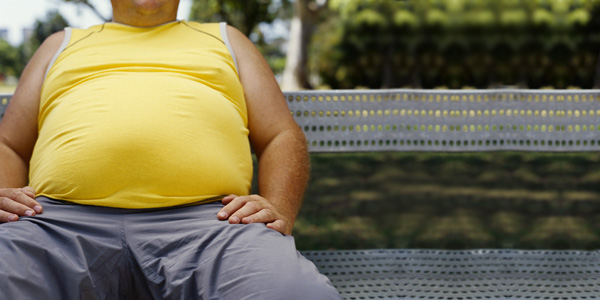Obesity affects over 130 million Americans. We all understand that obesity contributes to heart disease, diabetes, high blood pressure, high cholesterol, and certain cancers. What about your back? Traditionally, studies associating obesity with low back pain have been weak (1). Recently, more rigorous studies are showing that obesity is associated with low back pain.
Our spines carry our weight throughout the day, as we walk, sit, work and even getting in and out of the car. It is proven that while we stand, an obese patient changes in the motions of their spines. For example, the lumbar spine will hyperextend to adjust the center of gravity (2). This is due to the shift forward of a persons center of gravity as they become larger in weight. Excessive weight negatively affects common movements such as standing up, walking, forward bending and lateral bending (3).
It is also proved that prevalence of osteoarthritis is increased in overweight patients by 34% (17% in the knees, 7% in the spine, and 10% in other areas) (4). Unfortunately, the spine is not spared.
In a recent study published in a reputable journal (Spine), 92,936 patients were studied ages 20 years old and older. It was found that people with high value of body mass index (a measure of weight), were more likely to report low back pain than those with normal values (5). Additionally, obesity experience increased impairment of spine movement, that can contribute to back pains (6). Other factors known to increase your chances of low back pain include smoking and low physical activity.
Weight gain is a difficult problem to treat. If you have a hard time loosing weight, or maintaining your weight, please seek help- your back will thank you later.
REFERENCES
1. Leboeuf-Yde C. Body weight and low back pain. A systematic literature review of 56 journal articles reporting on 65 epidemiologic studies. Spine 2000;25:226–37.
2. Fabris de Souza SA, Faintuch J, Valezi AC, Sant'Anna AF, Gama-Rodrigues JJ, de Batista Fonseca IC, de Melo RD. Postural changes in morbidly obese patients. Obes Surg. 2005;15(7):1013–6.
3. Galli M, Crivellini M, Sibella F, Montesano A, Bertocco P, Parisio C. Sit-to-stand movement analysis in obese subjects. Int J Obes Relat Metab Disord. 2000;24(11):1488–92.
4. Mellin G, Harkapaa K, Vanharanta H, Hupli M, Heinonen R, Järvikoski A. Outcome of a multimodal treatment including intensive physical training of patients with chronic low back pain. Spine. 1993;18(7):825–829.
5. Heuch I, Hagen K, Heuch I, Nygaard Ø, Zwart JA. The impact of body mass index on the prevalence of low back pain: the HUNT study. Spine (Phila Pa 1976). 2010 Apr 1;35(7):764-8.
6. Effect of obesity and low back pain on spinal mobility: a cross sectional study in women. Vismara L, Menegoni F, Zaina F, Galli M, Negrini S, Capodaglio P. J Neuroeng Rehabil. 2010 Jan 18;7:3.

